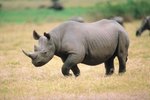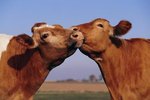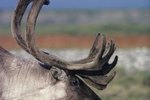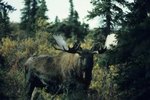
The largest of the deer family, moose average 5 to 6 1/2 feet tall and can weigh up to 1,800 pounds. These huge animals range across Alaska, Canada and the northern border of the United States in the Western Hemisphere. In the Eastern Hemisphere they range across northern Europe, primarily in the Scandinavian countries, northern Asia and Siberia. With such prevalence, you may see a moose in the wild. If you do, you may wonder how to differentiate between a cow moose and a bull moose. (see Reference 2 and 3)
Look Up
The easiest way to determine if you're looking at a bull moose is to look at its head. Bull moose have antlers that can span up to 6 feet. Cow moose don't have antlers. However, this isn't a failsafe method of determining sex. Moose, like all species in the deer family, lose their antlers in the wintertime and regrow them throughout spring and summer. Bull moose antlers can weigh up to 40 pounds.
Coloration
Cow moose have light-brown faces, whereas bulls have black or dark-brown muzzles. Cows also have a white patch of fur beneath their tail, which bulls do not have. Alaskan cow moose have reddish-brown faces, while the bulls have black faces.
Ring the Bell
Moose have a flap of skin with long hair hanging down from the chin: this is called the "bell." Bells are normally much bigger on bulls than on cows. The exact purpose of the bell is unknown, though Kristine Rines, a moose biologist for the state of New Hampshire, speculates that it might be for catching urine to display scent during the moose rut or mating season. It might also advertise a bull moose's fitness for mating.
Sexual Organs
Of course, if you're close enough to see a moose's sexual organs, you can determine whether the moose is a bull or a cow. But that may be a little too close for comfort, as moose can travel up to 35 miles per hour and give little warning before attacking. Males can be ornery during and after their mating season. Females can become very defensive when they have young with them.
References
Photo Credits
-
Jupiterimages/Photos.com/Getty Images




